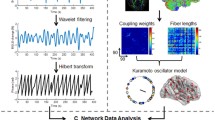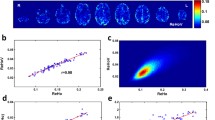Abstract
Studies of large-scale brain functional connectivity using the resting-state functional magnetic resonance imaging have advanced our understanding of human brain functions. Although the evidence of dynamic functional connectivity is accumulating, the variations of functional connectivity over time have not been well characterized. In the present study, we aimed to associate the variations of functional connectivity with the intrinsic activities of resting-state networks during a single resting-state scan by comparing functional connectivity differences between when a network had higher and lower intrinsic activities. The activities of the salience network, default mode network (DMN), and motor network were associated with changes of resting-state functional connectivity. Higher activity of the salience network was accompanied by greater functional connectivity between the fronto-parietal regions and the DMN regions, and between the regions within the DMN. Higher DMN activity was associated with less connectivity between the regions within the DMN, and greater connectivity between the regions within the fronto-parietal network. Higher motor network activity was correlated with greater connectivity between the regions within the motor network, and smaller connectivity between the DMN regions and fronto-parietal regions, and between the DMN regions and the motor regions. In addition, the whole brain network modularity was positively correlated with the motor network activity, suggesting that the brain is more segregated as sub-systems when the motor network is intrinsically activated. Together, these results demonstrate the association between the resting-state connectivity variations and the intrinsic activities of specific networks, which can provide insights on the dynamic changes in large-scale brain connectivity and network configurations.






Similar content being viewed by others
References
Achard S, Bullmore E (2007) Efficiency and cost of economical brain functional networks. PLoS Comput Biol 3:e17. doi:10.1371/journal.pcbi.0030017
Allen EA, Damaraju E, Plis SM, et al. (2012) Tracking whole-brain connectivity dynamics in the resting state. Cereb cortex (New York, NY: 1991). doi:10.1093/cercor/bhs352
Allman JM, Watson KK, Tetreault NA, Hakeem AY (2005) Intuition and autism: a possible role for Von Economo neurons. Trends Cogn Sci 9:367–373. doi:10.1016/j.tics.2005.06.008
Allman JM, Tetreault NA, Hakeem AY et al (2010) The von Economo neurons in frontoinsular and anterior cingulate cortex in great apes and humans. Brain Struct Funct 214:495–517. doi:10.1007/s00429-010-0254-0
Andrews-Hanna JR, Reidler JS, Sepulcre J et al (2010) Functional-anatomic fractionation of the brain’s default network. Neuron 65:550–562
Bassett DS, Wymbs NF, Porter MA et al (2011) Dynamic reconfiguration of human brain networks during learning. Proc Natl Acad Sci USA 108:7641–7646. doi:10.1073/pnas.1018985108
Beckmann CF, DeLuca M, Devlin JT, Smith SM (2005) Investigations into resting-state connectivity using independent component analysis. Philos Trans R Soc Lond B Biol Sci 360:1001–1013. doi:10.1098/rstb.2005.1634
Biswal B, Yetkin FZ, Haughton VM, Hyde JS (1995) Functional connectivity in the motor cortex of resting human brain using echo-planar MRI. Magn Reson Med: Off J Soc Magn Reson Med/Soc Magn Reson Med 34:537–541. doi:10.1002/mrm.1910340409
Biswal BB, Mennes M, Zuo X-N et al (2010) Toward discovery science of human brain function. Proc Natl Acad Sci USA 107:4734–4739. doi:10.1073/pnas.0911855107
Blondel VD, Guillaume J-L, Lambiotte R, Lefebvre E (2008) Fast unfolding of communities in large networks. J Stat Mech: Theory Exp 2008:P10008. doi:10.1088/1742-5468/2008/10/P10008
Bonnelle V, Ham TE, Leech R, et al. (2012) Salience network integrity predicts default mode network function after traumatic brain injury. Proc Natl Acad Sci 109(12):4690–4695. doi:10.1073/pnas.1113455109
Bullmore E, Sporns O (2009) Complex brain networks: graph theoretical analysis of structural and functional systems. Nat Rev Neurosci 10:186–198. doi:10.1038/nrn2575
Calhoun VD, Adali T, Pearlson GD, Pekar JJ (2001) A method for making group inferences from functional MRI data using independent component analysis. Hum Brain Mapp 14:140–151
Cauda F, Torta DME, Sacco K et al (2013) Functional anatomy of cortical areas characterized by Von Economo neurons. Brain Struct Funct 218:1–20. doi:10.1007/s00429-012-0382-9
Chan RCK, Di X, McAlonan GM, Gong Q (2011) Brain anatomical abnormalities in high-risk individuals, first-episode, and chronic schizophrenia: an activation likelihood estimation meta-analysis of illness progression. Schizophr Bull 37:177–188. doi:10.1093/schbul/sbp073
Chang C, Glover GH (2010) Time-frequency dynamics of resting-state brain connectivity measured with fMRI. NeuroImage 50:81–98. doi:10.1016/j.neuroimage.2009.12.011
Cole DM, Smith SM, Beckmann CF (2010) Advances and pitfalls in the analysis and interpretation of resting-state FMRI data. Frontiers Syst Neurosci 4:8. doi:10.3389/fnsys.2010.00008
Critchley HD, Elliott R, Mathias CJ, Dolan RJ (2000) Neural activity relating to generation and representation of galvanic skin conductance responses: a functional magnetic resonance imaging study. J Neurosci 20:3033–3040
Dimitriadis SI, Laskaris NA, Tsirka V et al (2012) An EEG study of brain connectivity dynamics at the resting state. Nonlinear Dynamics, Psychol Life Sci 16:5–22
Dosenbach NUF, Nardos B, Cohen AL et al (2010) Prediction of individual brain maturity using fMRI. Science (New York, NY) 329:1358–1361. doi:10.1126/science.1194144
Fan J, Xu P, Van Dam NT et al (2012) Spontaneous brain activity relates to autonomic arousal. J Neurosci 32:11176–11186
Fox MD, Snyder AZ, Vincent JL et al (2005) The human brain is intrinsically organized into dynamic, anticorrelated functional networks. Proc Natl Acad Sci USA 102:9673–9678
Friston KJ (1994) Functional and effective connectivity in neuroimaging: a synthesis. Hum Brain Mapp 2:56–78. doi:10.1002/hbm.460020107
Friston KJ, Harrison L, Penny W (2003) Dynamic causal modelling. NeuroImage 19:1273–1302
Goebel R, Roebroeck A, Kim D-S, Formisano E (2003) Investigating directed cortical interactions in time-resolved fMRI data using vector autoregressive modeling and Granger causality mapping. Magn Reson Imaging 21:1251–1261
Handwerker DA, Roopchansingh V, Gonzalez-Castillo J, Bandettini PA (2012) Periodic changes in fMRI connectivity. NeuroImage. doi:10.1016/j.neuroimage.2012.06.078
He Y, Chen Z, Evans A (2008) Structural insights into aberrant topological patterns of large-scale cortical networks in Alzheimer’s disease. J Neurosci: Off J Soc Neurosci 28:4756–4766. doi:10.1523/JNEUROSCI.0141-08.2008
Kang J, Wang L, Yan C et al (2011) Characterizing dynamic functional connectivity in the resting brain using variable parameter regression and Kalman filtering approaches. NeuroImage 56:1222–1234. doi:10.1016/j.neuroimage.2011.03.033
Kitzbichler MG, Henson RNA, Smith ML et al (2011) Cognitive effort drives workspace configuration of human brain functional networks. J Neurosci: Off J Soc Neurosci 31:8259–8270. doi:10.1523/JNEUROSCI.0440-11.2011
Kiviniemi V, Vire T, Remes J et al (2011) A sliding time-window ICA reveals spatial variability of the default mode network in time. Brain Connect 1:339–347. doi:10.1089/brain.2011.0036
Laird AR, Eickhoff SB, Li K et al (2009) Investigating the functional heterogeneity of the default mode network using coordinate-based meta-analytic modeling. J Neurosci: Off J Soc Neurosci 29:14496–14505. doi:10.1523/JNEUROSCI.4004-09.2009
Liao W, Marinazzo D, Pan Z et al (2009) Kernel Granger causality mapping effective connectivity on FMRI data. IEEE Trans Med Imaging 28:1825–1835. doi:10.1109/TMI.2009.2025126
Liao W, Mantini D, Zhang Z et al (2010) Evaluating the effective connectivity of resting state networks using conditional Granger causality. Biol Cybern 102:57–69
Liao W, Ding J, Marinazzo D et al (2011) Small-world directed networks in the human brain: multivariate Granger causality analysis of resting-state fMRI. NeuroImage 54:2683–2694. doi:10.1016/j.neuroimage.2010.11.007
Liu X, Duyn JH (2013) Time-varying functional network information extracted from brief instances of spontaneous brain activity. Proc Natl Acad Sci 110(11):4392–4397. doi:10.1073/pnas.1216856110
Manoliu A, Riedl V, Doll A et al (2013a) Insular dysfunction reflects altered between-network connectivity and severity of negative symptoms in schizophrenia during psychotic remission. Frontiers Humn Neurosci. doi:10.3389/fnhum.2013.00216
Manoliu A, Riedl V, Zherdin A, et al. (2013b) Aberrant dependence of default mode/central executive network interactions on anterior insular salience network activity in Schizophrenia. Schizophr Bull. doi:10.1093/schbul/sbt037
Menon V (2011) Large-scale brain networks and psychopathology: a unifying triple network model. Trends Cogn Sci 15:483–506. doi:10.1016/j.tics.2011.08.003
Menon V, Uddin LQ (2010) Saliency, switching, attention and control: a network model of insula function. Brain Struct Funct 214:655–667. doi:10.1007/s00429-010-0262-0
Newman MEJ (2006) Modularity and community structure in networks. Proc Natl Acad Sci USA 103:8577–8582. doi:10.1073/pnas.0601602103
Palaniyappan L, Liddle PF (2012) Does the salience network play a cardinal role in psychosis? An emerging hypothesis of insular dysfunction. J Psychiatry Neurosci: JPN 37:17–27. doi:10.1503/jpn.100176
Raichle ME, MacLeod AM, Snyder AZ et al (2001) A default mode of brain function. Proc Natl Acad Sci USA 98:676–682. doi:10.1073/pnas.98.2.676
Rubinov M, Sporns O (2010) Complex network measures of brain connectivity: uses and interpretations. NeuroImage 52:1059–1069. doi:10.1016/j.neuroimage.2009.10.003
Rubinov M, Sporns O (2011) Weight-conserving characterization of complex functional brain networks. NeuroImage 56:2068–2079. doi:10.1016/j.neuroimage.2011.03.069
Rubinov M, Knock SA, Stam CJ et al (2009) Small-world properties of nonlinear brain activity in schizophrenia. Hum Brain Mapp 30:403–416. doi:10.1002/hbm.20517
Seeley WW, Menon V, Schatzberg AF et al (2007) Dissociable intrinsic connectivity networks for salience processing and executive control. J Neurosci: Off J Soc Neurosci 27:2349–2356. doi:10.1523/JNEUROSCI.5587-06.2007
Seghier ML, Friston KJ (2013) Network discovery with large DCMs. NeuroImage 68:181–191. doi:10.1016/j.neuroimage.2012.12.005
Shulman GL, Fiez JA, Corbetta M et al (1997) Common blood flow changes across visual tasks: II. decreases in cerebral cortex. J Cogn Neurosci 9:648–663. doi:10.1162/jocn.1997.9.5.648
Spreng RN, Sepulcre J, Turner GR et al (2013) Intrinsic architecture underlying the relations among the default, dorsal attention, and frontoparietal control networks of the human brain. J Cogn Neurosci 25:74–86. doi:10.1162/jocn_a_00281
Sridharan D, Levitin DJ, Menon V (2008) A critical role for the right fronto-insular cortex in switching between central-executive and default-mode networks. Proc Natl Acad Sci USA 105:12569–12574. doi:10.1073/pnas.0800005105
Stephan KE, Kasper L, Harrison LM et al (2008) Nonlinear dynamic causal models for fMRI. NeuroImage 42:649–662. doi:10.1016/j.neuroimage.2008.04.262
Tagliazucchi E, Balenzuela P, Fraiman D, Chialvo DR (2012) Criticality in large-scale brain FMRI dynamics unveiled by a novel point process analysis. Frontiers Physiol 3:15. doi:10.3389/fphys.2012.00015
Vanhaudenhuyse A, Demertzi A, Schabus M et al (2011) Two distinct neuronal networks mediate the awareness of environment and of self. J Cogn Neurosci 23:570–578. doi:10.1162/jocn.2010.21488
Watts DJ, Strogatz SH (1998) Collective dynamics of “small-world” networks. Nature 393:440–442. doi:10.1038/30918
Wu G-R, Liao W, Stramaglia S et al (2013) A blind deconvolution approach to recover effective connectivity brain networks from resting state fMRI data. Med Image Anal 17:365–374. doi:10.1016/j.media.2013.01.003
Yan C, He Y (2011) Driving and driven architectures of directed small-world human brain functional networks. PLoS ONE 6:e23460. doi:10.1371/journal.pone.0023460
Zhuang J, LaConte S, Peltier S et al (2005) Connectivity exploration with structural equation modeling: an fMRI study of bimanual motor coordination. NeuroImage 25:462–470. doi:10.1016/j.neuroimage.2004.11.007
Acknowledgments
This study was supported by a National Institute of Health grant 5R01AG032088. We thank Suril Gohel and Dr. Eun H. Kim for discussions on data analysis and comments on an earlier version of this manuscript.
Author information
Authors and Affiliations
Corresponding author
Electronic supplementary material
Below is the link to the electronic supplementary material.
Rights and permissions
About this article
Cite this article
Di, X., Biswal, B.B. Dynamic brain functional connectivity modulated by resting-state networks. Brain Struct Funct 220, 37–46 (2015). https://doi.org/10.1007/s00429-013-0634-3
Received:
Accepted:
Published:
Issue Date:
DOI: https://doi.org/10.1007/s00429-013-0634-3




